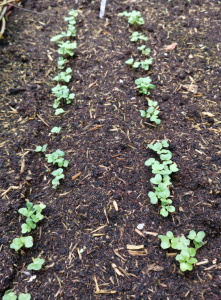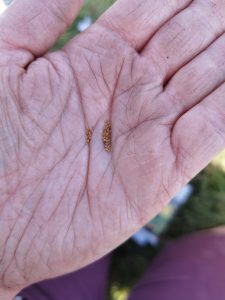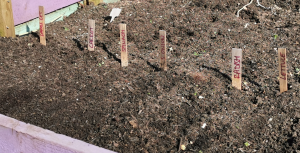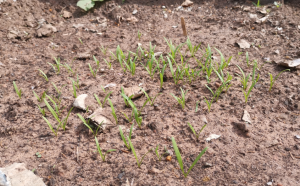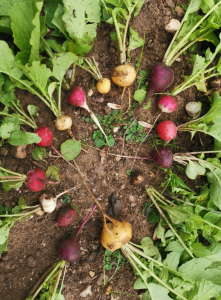
Sow and Grow with The Conservation Volunteers in Birmingham
Salad Growing in the UK
Most salad crops grow well in the UK. I grow mine both on my allotment and at home in raised beds in the back garden, but you can easily grow leaves and smaller crops (radish & spring onion) in trough planters on doorsteps, windowsills, or even in hanging baskets. These crops do not require pollination as they shouldn’t be left to flower, so they don’t need to be outside.
The crops you grow depend on what you like to eat! I try to grow lots of leaves so that I have a variety for my side salads. Things I grow include:
- Red-veined sorrel
- Spinach
- Rocket
- Mizuna (similar to rocket but more fancy)
- Lollo rosso lettuce
- Mixed lettuce leaves
- Spring onion
- Radish
- Nasturtium (an edible flower)
If you click on each word it will take you to a page with more information about each crop.
All of these can be grown in pots on windowsills and don’t require very deep soil – 4-10cm deep is enough. Radish has the biggest room requirements out of these crops as they need space for the root to swell into the actual radish. Some varieties are long and thin whereas others are short and round (I can relate).
Seed Spacing
So how do you place and space your crops? Remember that as things grow they will put out leaves and these need room. Most of these leaves are the ones we want to eat! Lettuce, rocket, spinach, sorrel and nasturtium are all nicer to eat when the leaves are smaller, so pick them when they are 5-8cm long, or 5cm across for nasturtium.
Instead of sowing in rows, try bodging individual shallow holes (1cm deep max) at the spacing you want, and putting one seed per hole. Each seed packet will have the suggested spacings on the back but here’s a quick guide;
- Red-veined sorrel: 1 seed, 15cm apart
- Spinach: 1 seed, 10cm apart
- Rocket: 1 seed (they are TINY – like dust!), 5cm apart
- Mizuna (similar to rocket but more fancy): 5cm apart
- Lollo rosso lettuce: 1 seed (tiny), 10cm apart
- Mixed lettuce leaves: 1 seed (tiny), 10cm apart
- Spring onion: 1 seed per hole, 4-5cm apart
- Radish: 1 seed per hole, 5cm apart
- Nasturtium: 1 seed, 10-12cm apart. You only need one or two plants as they can take over. The seeds are big so this a good one to plant with kids.
As some of these seeds are tiny don’t worry if you put two or more in one hole. You can pull out the wants you don’t want when they start to grow. Remember to label your rows – most seedlings look exactly the same! I use lollipop sticks from Poundland for this.
If you are growing these outside, it is a good idea to put some netting over the planter or raised bed to stop the birds eating the seeds or eating the seedlings as they start to poke up. I absolutely do not suggest using pea netting as it rips easily, birds get tangled in it very easily, and it is difficult to re-use. I would instead suggest something more sturdy like this garden mesh from Wilkos.
This mesh is more expensive, but it lasts for ages, protects crops, doesn’t entrap animals, allows air and water in (which is good!), and it can be reused year on year. Fix it into place using tent pegs, bricks, or staple gun it onto the side of the raised bed (this is what I do on the allotment).
Time to Sow, Sow, Sow!
- Mark out your rows – you can put a lollipop stick at the start and the end or use some string to get a straight line. You could also just wing it and see what happens!
- Bodge holes along the row. Aim for no deeper than 1cm. Lots of these seeds don’t actually need to be very deep at all.
- Put one seed per hole. It is easier to keep rows all the same plant, so a row of radish, a row of spring onion, a row of spinach etc.
- Gently cover over the seeds by brushing the soil/compost over them, and gently press it down with the palm of your hand.
- Use a watering can with a rose (sprinkler) on the end and water the seeds. Make sure you use a drip tray, bowl or plate (or similar) if you are doing this indoors so the water doesn’t go everywhere!
- Put netting over them if necessary.
- Sit back and wait! Radish will probably be the first seeds to come up.
Succession Sowing
Some crops lend themselves well to succession sowing. This is something we do at our Community Growspace sites. The idea is that by sowing some seeds at three-week or five-week intervals, you get a continuous crop of that veg.
Radish will be ready to eat five or six weeks after sowing the seed, so if you sow radish now, sow more in three weeks time, more three weeks after that, and sow on (sorry, pun) throughout the summer, you will have a continuous crop of radish. This also works with spring onion, beans, peas, carrots, beetroot – most crops!
Quantities
Lots of these plants will keep cropping right through the summer. The idea is that you only pick or cut the leaves you want to eat. For radish and spring onion, you pull the whole thing up to use. For the salad leaves (sorrel, spinach, lettuce, lollo rosso, rocket, mizuna, nasturtium) you only pick individual leaves that you want.
For a family of four you probably only need one or two plants of each. The more you pick the more they will grow.
Hints and Tips
If you have any questions, Laura is happy to answer them via email, Facebook or Twitter
- Email: Laura.Hamilton@TCV.org.uk
- Facebook: Health For Life in the Community
- Twitter: TCV_Birmingham
Remember to share your pictures with us on Facebook and Twitter too!
